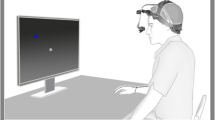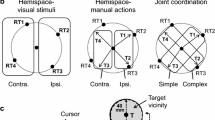Abstract
The initiation of coupled eye and arm movements was studied in six patients with mild cerebellar dysfunction and in six age-matched control subjects. The experimental paradigm consisted of 40 deg step-tracking elbow movements made under different feedback conditions. During tracking with the eyes only, saccadic latencies in patients were within normal limits. When patients were required to make coordinated eye and arm movements, however, eye movement onset was significantly delayed. In addition, removal of visual information about arm versus target position had a pronounced differential effect on movement latencies. When the target was extinguished for 3 s immediately following a step change in target position, both eye and arm onset times were further prolonged compared to movements made to continuously visible targets. When visual information concerning arm position was removed, onset times were reduced. Eye and arm latencies in control subjects were unaffected by changes in visual feedback. The results of this study clearly demonstrate that, in contrast to earlier reports of normal saccadic latencies associated with cerebellar dysfunction, initiation of both eye and arm movements is prolonged during coordinated visuomotor tracking thus supporting a coordinative role for the cerebellum during oculo-manual tracking tasks.
Similar content being viewed by others
References
Aschoff JC, Cohen B (1971) Changes in saccadic eye movements produced by cerebellarcortical lesions. Exp Neurol 32:123–133
Baloh RW, Konrad HR, Honrubia V (1985) Vestibuloocular function in patients with cerebellar atrophy. Neurology 25:160–168
Becker WJ, Kunesch E, Freund H-J (1990) Coordination of a multijoint movement in normal humans and in patients with cerebellar dysfunction. Can J Neurol Sci 17:264–274
Beppu H, Suda M, Tanaka R (1984) Analysis of cerebellar motor disorders by visually guided elbow trackingmovements. Brain 107:787–809
Biguer Jeannerod M, Prablanc C (1982) The coordination of eye, head and arm movements during reaching at a single visual target. Exp Brain Res 46:301–304
Braitenberg V (1967) Is the cerebellar cortex a biological clock in the millisecond range? Prog Brain Res 25:334–346
Brooks VB (1986) The neural basis of motor control. Oxford University Press, New York pp 256–289
Brown SH, Hefter H, Cooke JD, Freund H-J (1989) Duration of movement-related EMG activity in patients with mild cerebellar dysfunction. Soc Neurosci Abstr 15:473.2
Brown SH, Hefter H, Mertens M, Freund H-J (1990) Disturbances in human arm movement trajectory due to mild cerebellar dysfunction. J Neurol Neurosurg Psychiat 53:306–313
Brown SH, Kessler K, Hefter H, Cooke JD, Freund H-J (1991) Initiation of eye and arm movements in patients with mild cerebellar ataxia. IBRO Proc P65.14
Carnahan H, Marteniuk RG (1991) The temporal organization of hand, eye and head movements during reaching and pointing. J Mot Behav 23:109–119
Chapman CE, Spidalieri G, Lamarre Y (1986) Activity of dentate neurons during arm movements triggered by visual, auditory, and somesthetic stimuli in the monkey. J Neurophysiol 55:203–226
Deng S-Y, Goldberg ME, Segraves MA, Ungerleider LG, Mishkin M (1986) The effect of unilateral ablation of the frontal eye fields on saccadic performance in the monkey. In: Keller E, Zee DS (eds), Adaptive processes in the visual and oculomotor systems. Pergamon, Oxford, pp 201–208
Fischer B, Rogal L (1986) Eye-hand-coordination in man: a reaction time study. Biol Cybern 55:253–261
Fisk JD, Goodale MA (1985) The organization of eye and limb movements during unrestricted reaching to target in contralateral and ipsilateral visual space. Exp Brain Res 60:159–178
Fleischer AG (1989) Planning and execution of hand movements. Biol Cybern 60:311–321
Gauthier GM, Hofferer JM (1976) Eye tracking of self-moved targets in the absence of vision. Exp Brain Res 26:121–139
Gauthier GM, Mussa Ivaldi F (1988) Oculo-manual tracking of visual targets in monkey: role of the arm afferent information in the control of arm and eye movements. Exp Brain Res 73:138–154
Gauthier GM, Vercher J-L, Mussa Ivaldi F, Marchetti E (1988) Oculo-manual tracking of visual targets: control learning, coordination control and coordination model. Exp Brain Res 73:127–137
Gielen CCAM, Van den Heuvel PJM, Van Ginsbergen JAM (1984) Coordination of fast eye and arm movements in a tracking task. Exp Brain Res 56:154–161
Glickstein M, Cohen JL, Dixon B, Gibson A, Hollins M, Labossiere E, Robinson F (1980) Corticopontine visual projections in macaque monkeys. J Comp Neurol 190:209–229
Gnadt JW, Anderson RA (1988) Memory related motor planning activity in posterior parietal cortex of macaque. Exp Brain Res 70:216–220
Hallett M, Berardelli A, Matheson J Rothwell J, Marsden CD (1991) Physiological analysis of simple rapid movements in patients with cerebellar deficits. J Neurol Neurosurg Psychiat 53:124–133
Harding AE (1984) The hereditary ataxias and related disorders Churchill Livingstone, Edinburgh, pp 166–173
Herman R, Herman R, Maulucci R (1981) Visually triggered eyearm movements in man. Exp Brain Res 42:392–398
Hikosada O, Wurtz RH (1989) The basal ganglia In: Wurtz RH, Goldberg ME (eds) Reviews of oculomotor research Vol. 3. The neurobiology of saccadic eye movements. Elsevier, Amsterdam, pp 257–282
Holmes G (1917) The symptoms of acute cerebellar injuries due to gunshot injuries. Brain 40:461–535
Hore J, Wild B, Diener H-C (1991) Cerebellar dysmetria at the elbow, wrist and fingers. J Neurophysiol 65:563–571
Inhoff AW, Diener HC, Rafal RD, Ivry R (1989) The role of cerebellar structures in the execution of serial movements. Brain 112:565–581
Ivry RB, Keele SW, Diener HC (1988) Dissociation of the lateral and medial cerebellum in movement timing and movement execution. Exp Brain Res 73:167–180
Keele SW, Ivry RB (1991) Does the cerebellum provide a common computation for diverse tasks? Ann NY Acad Sci 608: 179–211
Keller EL (1989) The Cerebellum. In: Wurtz RH, Goldberg ME (eds) Reviews of oculomotor research Vol. 3. The neurobiology of saccadic eye movements. Elsevier, Amsterdam, pp 391–411
Kornhuber HH (1973) Cerebellar control of eye movements. Adv Oto Rhino Laryngol 19:241–253
Lamarre Y, Bioulac B, Jacks B (1978) Involvement of the cerebellum in the initiation of fast ballistic movements in the monkey. Electroencephalogr Clin Neurophysiol 40:1038–1050
Marple-Horvat DE, Stein JF (1990) Neuronal activity in the lateral cerebellum of trained monkeys related to visual stimuli or to eye movements. J Physiol (Lond) 428:595–614
Mather JA, Lackner JR (1981) The influence of afferent, proprioceptive and timing factors on the accuracy of eye-hand tracking. Exp Brain Res 43:406–412
Meyer-Lohmann J, Hore J, Brooks VB (1977) Cerebellar participation in generation of prompt arm movements. J Neurophphysiol 40:1038–1050
Miller AD, Brooks VB (1982) Parallel pathways for movement initiation in monkeys. Exp Brain Res 45:328–332
Prablanc C, Echallier JF, Komilis E, Jeannerod M (1979) Optimal response of eye and hand motor systems in pointing at a visual target. I. Spatio-temporal characteristics of eye and hand movements and their relationships when varying the amount of visual information. Biol Cybern 35:113–124
Prablanc C, Pelisson D, Goodale MA (1986) Visual control of reaching movements without vision of the limb. I. Role of retinal feedback of target position in guiding the hand. Exp Brain Res 62:293–302
Ritchie L (1976) Effects of cerebellar lesions on saccadic eye movements. J. Neurophysiol 39:1246–1256
Selhorst JB, Stark L, Ochs AL, Hoyt WF (1976) Disorders in cerebellar motor control. I. Saccadic overshoot dysmetria: an oculographic, control system and clinico-anatomical analysis. Brain 99:497–508
Spidalieri G, Busby L, Lamarre Y (1983) Fast ballistic arm movements triggered by visual, auditory, and somesthetic stimuli in the monkey. II. Effects of unilateral dentate lesion on discharge of precentral cortical neurons and reaction time. J Neurophysiol 50:1359–1379
Steinbach MJ, Held R (1968) Eye tracking of observer-generated target movements. Science 161:187–188
Trouche E, Beaubaton D (1980) Initiation of a goal-directed movement in the monkey. Role of the cerebellar dentate nucleus. Exp Brain Res 40:311–321
Vercher J-L, Gauthier GM (1988) Cerebellar involvement in the coordination control of the oculo-manual tracking system: effects of cerebellar dentate nucleus lesion. Exp Brain Res 73:155–166
Vilis T, Hore J (1981) Characteristics of saccadic dysmetria in monkeys during reversible lesions of medial cerebellar nuclei. J Neurophysiol 46:828–837
Vilis T, Hore J (1984) A comparison of disorders in saccades and in fast and accurate elbow flexions during cerebellar dysfunction. Prog Brain Res 64:207–215
Vilis T, Snow R, Hore J (1983) Cerebellar saccadic dysmetria is not equal in the two eyes. Exp Brain Res 51:343–350
Warabi T, Noda H, Kato T (1986) Effect of aging on sensorimotor functions of eye and hand movements. Exp Neurol 92:686–697
Zee DS, Yee RD, Cogan DG, Robinson DA, Engel WK (1976) Oculor motor abnormalities in hereditary cerebellar ataxia. Brain 99:207–234
Author information
Authors and Affiliations
Rights and permissions
About this article
Cite this article
Brown, S.H., Kessler, K.R., Hefter, H. et al. Role of the cerebellum in visuomotor coordination. Exp Brain Res 94, 478–488 (1993). https://doi.org/10.1007/BF00230206
Received:
Accepted:
Issue Date:
DOI: https://doi.org/10.1007/BF00230206




